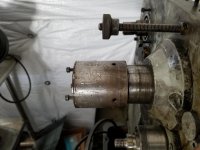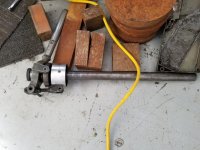Hi everyone. I am trying to get this piece off the spindle shaft. Its for a 5c collet lever attachment. This piece mounts onto the spindle shaft and I have removed the 2 set screws that installed. I have tried unscrewing it and slide hammer it off. I got it to move about 1/16th but that is it. I don't want to damage it and thought i should ask before hurting something. Any tips would be much appreciated.
How to install the app on iOS
Follow along with the video below to see how to install our site as a web app on your home screen.
Note: This feature may not be available in some browsers.
You are using an out of date browser. It may not display this or other websites correctly.
You should upgrade or use an alternative browser.
You should upgrade or use an alternative browser.
How to remove this piece from a 5c collect lever attachment?
- Thread starter abadsvt
- Start date
- Replies 20
- Views 2,158
eKretz
Diamond; Mod Squad
- Joined
- Mar 27, 2005
- Location
- Northwest Indiana, USA
Most I've seen were threaded on then set screws were tightened to lock in place. You may have damaged the threads already if you were whaling on it with a slide hammer. What is the make and model of the lathe?
thermite
Diamond
- Joined
- Sep 21, 2011
Hi everyone. I am trying to get this piece off the spindle shaft. Its for a 5c collet lever attachment. This piece mounts onto the spindle shaft and I have removed the 2 set screws that installed. I have tried unscrewing it and slide hammer it off. I got it to move about 1/16th but that is it. I don't want to damage it and thought i should ask before hurting something. Any tips would be much appreciated.
Once had one, looked much like it. "Royal" brand?
What eKretz said.
If you had already slide-hammered it and jammed it BEFORE asking?
You have almost certainly already damaged it, too. "Want to" or otherwise.

Thanks guys. I tried for a while to get it to unscrew before trying the slide hammer. I got it to twist but had to use a long cheater bar. Thats how tight it was and it did rotate but very, very hard and it didn't really move in regards to "unscrewing". I bought the lathe used so they might have damaged the threads when they put it on. Or maybe i did mess it up. I will give "screwing" another try. Thanks for the help!
thermite
Diamond
- Joined
- Sep 21, 2011
Thanks guys. I tried for a while to get it to unscrew before trying the slide hammer. I got it to twist but had to use a long cheater bar. Thats how tight it was and it did rotate but very, very hard and it didn't really move in regards to "unscrewing". I bought the lathe used so they might have damaged the threads when they put it on. Or maybe i did mess it up. I will give "screwing" another try. Thanks for the help!
I could be wrong. It has been several years, and I abandoned fit-up in favour of "nose mount" closers - no drawtube - that saved me precious through-spindle space.
But my fading memory is that the attachment mechanism you seek is UNDER that shiney protective collar, whose function is partly to reduce risk of snagging "stuff" on the more intricate goods it covers and to keep them clean so they can do their job consistently.
The cover itself was an easy item to move. If one knew how.
And it was not entombed in varnish.
Prior owner MAY have buggered it, yes.. Even so, torqueing the piss out of it and slide-hammering it was not one of your best-ever moves.
It doesn't LOOK like a truck axle you already have the new one in-hand to replace, does it?
Finesse is called for around machine-tools and their accessories. Not the "BFBI" route:
Brute Force and Bloody Ignorance - How is Brute Force and Bloody Ignorance abbreviated?

Danny VanVoorn
Titanium
- Joined
- Nov 3, 2002
- Location
- St.Louis, Missouri, USA
Mine came off with the knock out bar I made for removing the morse reducing sleeve on the other end. The set screws did put risers where they were on the spindle and they actually cut a little groove out of that adapter on the way off. It was just a smooth bore, not threaded on or anything like that but it was a good fit.
Dan
Dan
FredC
Diamond
- Joined
- Oct 29, 2010
- Location
- Dewees Texas
What if that thing has a key in it? Twisting on it will only wreck things. It would be good to know what the original spindle looked like. Pretty smart people are here on this forum, maybe make and model of the lathe will reveal what is on the end of the spindle. Slide hammer would not do anything good for the spindle bearings either.
While the OP is waiting for more info forcing light oil into the set screw holes may help.
While the OP is waiting for more info forcing light oil into the set screw holes may help.
Limy Sami
Diamond
- Joined
- Jan 7, 2007
- Location
- Norfolk, UK
There could be several reasons why it won't come off, fubared threads if it's screwed on, set screw dimples gouging, galling because it was assembled dry, galling because at some time it's spun, or plain old rustetc etc etc
As I don't like hammering hard on bearings - especially m/c tool spindle I'd slit it with a zip disc and make a new one and be done with it, ......doesn't look that hard to make.
I'd slit it with a zip disc and make a new one and be done with it, ......doesn't look that hard to make.
As I don't like hammering hard on bearings - especially m/c tool spindle
 I'd slit it with a zip disc and make a new one and be done with it, ......doesn't look that hard to make.
I'd slit it with a zip disc and make a new one and be done with it, ......doesn't look that hard to make.thermite
Diamond
- Joined
- Sep 21, 2011
......doesn't look that hard to make.
Not so much "hard" as not worth the time. IIRC, a thinwall shell, bulkhead with "features" at one end, so TiG else tedious boring of even heavy-wall tubing rather than solid.
These are not exactly "dime a dozen" common, these handlever closers but they are "out there" sometimes even as parts. Better route than making might be to just seek another one.
Or - as I did - a Sjogren AND(or) a Hardinge nose-mount "loop" closer instead. Shedding the need of a drawtube is a plus on a tight-choked 10EE.
rons
Diamond
- Joined
- Mar 5, 2009
- Location
- California, USA
I have removed the 2 set screws that installed. I have tried unscrewing it and slide hammer it off. I got it to move about 1/16th but that is it.
I use a 5x magnifier for something like that. Since you already moved the piece, you should be able to look into the holes using a strong light and a magnifier to see if there is a thread. Or what is left of the thread.
A few times I have taken apart threaded metal collars from shafts, which are secured with set screws that dent the threads. On reassembly I turn small disks of aluminium and insert into the set screw holes and torque the set screws with no damage.
I use a 5x magnifier for something like that. Since you already moved the piece, you should be able to look into the holes using a strong light and a magnifier to see if there is a thread. Or what is left of the thread.
A few times I have taken apart threaded metal collars from shafts, which are secured with set screws that dent the threads. On reassembly I turn small disks of aluminium and insert into the set screw holes and torque the set screws with no damage.
Yup, what he said ^
And....check for set screws on top of each other, seen it done for locking.
Forestgnome
Stainless
- Joined
- Aug 2, 2008
- Location
- Californeeeah
Check for additional set screws. Sometimes people lock set screws in place by putting another one on top.
Limy Sami
Diamond
- Joined
- Jan 7, 2007
- Location
- Norfolk, UK
Another thought - can the threaded holes in the end be used with longer screw as pushers?
Thanks guys. There is some good ideas on here. I am going to try to use the set screw holes to see if i can get it to "unscrew". I am thinking its pressed on more than screwed on by looking at closer now. I know there is not a Key in there or anything cause there is no slot for it on the part. If that doesn't work i am just going to cut it off. I would prefer to use a collet style anyways and i can always just remake this part. Its pretty basic. Thanks for the ideas. It helped me with a plan of attack!!!!!!
Josh
Josh
thermite
Diamond
- Joined
- Sep 21, 2011
plan of attack!!!!!!
Easy, Josh..
"attack" was where the problem came in !!!
Leaving (most of) a closer in-place is sometimes possible when switching-over to use of a chuck, but the drawtubes can get noisy, then beat-up, so it is best to take it clear-off.
That switch needs to be fast and slick. Once set-up, it usually IS.
SIP6A
Titanium
- Joined
- May 29, 2003
- Location
- Temperance, Michigan
Is it by chance a left hand thread?
TeachMePlease
Diamond
- Joined
- Feb 11, 2014
- Location
- FL
Is it by chance a left hand thread?
If it was, it's not anymore!
Limy Sami
Diamond
- Joined
- Jan 7, 2007
- Location
- Norfolk, UK
Is it by chance a left hand thread?
Good point SIP.
thermite
Diamond
- Joined
- Sep 21, 2011
Well, at this point, there's always black powder.....
Not. Ballistite, rather. Formed as a linear shaped charge "tape" with adhesive.
Cheap, and cuts like a waterjet. Clear through a tank hull, too, in the right sizes.
That wasn't for use in an attack. Too hard to get the buggers INSIDE the tank to cooperate!
Used for cutting up and clearing wreckage, rather. Steelworks of bombed buildings and bridges, etc. where a guy with a torch might be killed when it moved and collapsed further.
Bridge failed in Morgantown, WV a long time ago, (peacetime..) Dad was the one who dropped the wreckage right into barges. He used multiple thermite charges for that one so as to cut it up and not risk welder's lives nor break a single window.
Hope that doesn't apply HERE, but yah never know... our man DID start OUT with a right heavy-hand, so..

Similar threads
- Replies
- 5
- Views
- 379
- Replies
- 9
- Views
- 736



